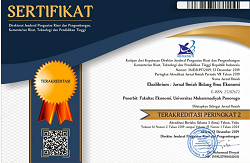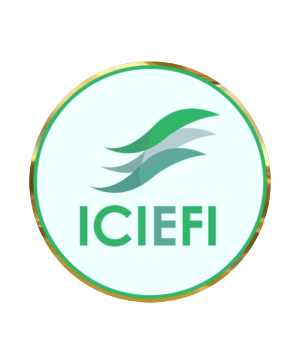Sustainable Business Model in Small and Medium-Sized Enterprises: A Study in Yogyakarta and Magelang
DOI: 10.24269/ekuilibrium.v18i2.2023.pp213-226
Abstract
This study aims to analyze Yogyakarta and Magelang Small and Medium-Sized Enterprises (hereafter) SMEs based on sustainable business model implementation. This study gives new evidence of Yogyakarta and Magelang SMEs’ businesses based on sustainable business model where Indonesian SMEs’ experience the economic crash of Covid-19. This study uses a qualitative descriptive method. Specifically, uses method of qualitative evaluative where this study evaluates SMEs business process by using sustainable business model. Research sample includes 40 SMEs in Yogyakarta and Magelang. Evaluation of SMEs’ business is based on elements of sustainable business model including key partner, key activity, key resources, value proposition, customer relationship, channels, customer segment, cost structure, revenue stream, cash flow management, pivoting plan, and ecological concern. This study uses a “yes and no” questionaries with 13 questions that refers to the elements of sustainable business. Based on the result, this study finds that most SMEs in Yogyakarta and Magelang, implement the elements of a key partner, key activity, key resources, value proposition, customer relationship, channels, cost structure, pivoting plan, and ecological concern. On the other hand, most SMEs do not implement elements of customer segment, revenue stream, and cash flow management. Socialization and special training is needed from various parties related to the implementation of sustainable business models for SMEs.
Keywords
Sustainable Business Model, Small and Medium-Sized Enterprises, Covid-19
References
- Amalia, A. D., & Melati, F. C. (2021). Analysis of MSMEs Recovery using Digital Technology in the Covid-19 Pandemic Era. Jurnal Ilmiah Bidang Ilmu EkonomI, 16(2), 117–128. https://doi.org/https://doi.org/10.24269/ekuilibrium.v16i2.%25y.pp117-128
- Andries, P., Daou, A., & Verheyden, L. (2019). Innovation as a vehicle for improving socially vulnerable groups’ access to basic provisions: A research note on the development of a questionnaire module. Research Policy, 48(1), 281–288. https://doi.org/10.1016/j.respol.2018.08.017
- Antikainen, M., & Valkokari, K. (2016). A Framework for Sustainable Circular Business Model Innovation. Technology Innovation Management Review, 6(7), 5–12. https://doi.org/10.22215/timreview1000
- Aziz, K. A., Wulandari, S., & Sagita, B. H. (2018). Perancangan Model Bisnis Ukm Atelier Prana dengan menggunakan Pendekatan Business Model Canvas. E-Proceeding of Engineering, 5(3), 6828. http://forschungsunion.de/pdf/industrie_4_0_umsetzungsempfehlungen.pdf%0Ahttps://www.dfki.de/fileadmin/user_upload/import/9744_171012-KI-Gipfelpapier-online.pdf%0Ahttps://www.bitkom.org/ sites/default/files/ pdf/Presse/Anhaenge-an-PIs/ 2018/180607 -Bitkom
- Barth, H., Ulvenblad, P., Ulvenblad, P. O., & Hoveskog, M. (2021). Unpacking sustainable business models in the Swedish agricultural sector– the challenges of technological, social and organisational innovation. Journal of Cleaner Production, 304, 127004. https://doi.org/10.1016/j.jclepro.2021.127004
- Boons, F., & Lüdeke-Freund, F. (2013). Business models for sustainable innovation: State-of-the-art and steps towards a research agenda. Journal of Cleaner Production, 45, 9–19. https://doi.org/10.1016/j.jclepro.2012.07.007
- Bouwman, H., Nikou, S., & de Reuver, M. (2019). Digitalization, business models, and SMEs: How do business model innovation practices improve performance of digitalizing SMEs? Telecommunications Policy, 43(9), 101828. https://doi.org/10.1016/j.telpol.2019.101828
- Carter, M., & Carter, C. (2020). The Creative Business Model Canvas. Social Enterprise Journal, 16(2), 141–158. https://doi.org/10.1108/SEJ-03-2019-0018
- Cavallari, M., De Marco, M., Rossignoli, C., & Casalino, N. (2015). Risk, Human Behavior, and Theories in Organizational Studies. Fourteenth Wuhan International Conference on E-Business, July, 284–297.
- Fabeil, N. F., Pazim, K. H., & Langgat, J. (2020). The Impact of Covid-19 Pandemic Crisis on Micro-Enterprises: Entrepreneurs’ Perspective on Business Continuity and Recovery Strategy. Journal of Economics and Business, 3(2). https://doi.org/10.31014/aior.1992.03.02.241
- Feng, J., Liu, Z., & Feng, L. (2021). Identifying opportunities for sustainable business models in manufacturing: Application of patent analysis and generative topographic mapping. Sustainable Production and Consumption, 27, 509–522. https://doi.org/10.1016/j.spc.2021.01.021
- Fitriasari, F. (2020). How do Small and Medium Enterprises ( SMEs ) Survive the COVID-19 Outbreak ? Research method. 05(02), 53–62.
- Fitriyani, I., Karmeli, E., Rahayu, S., & ... (2021). Meningkatkan Eksistensi Enterpreneur Melalui Strategi Manajemen Bisnis Di Era Pandemi. Jurnal …, 194–200. http://e-journallppmunsa.ac.id/index.php/jpml/article/view/395
- França, C. L., Broman, G., Robèrt, K. H., Basile, G., & Trygg, L. (2017). An approach to business model innovation and design for strategic sustainable development. Journal of Cleaner Production, 140, 155–166. https://doi.org/10.1016/j.jclepro.2016.06.124
- Gourinchas, P.-O., Kalemli-Ozcan, S., Penciakova, V., & Sander, N. (2020). COVID-19 and SME Failures. IMF Working Papers, 20(207). https://doi.org/10.5089/9781513557748.001
- Grant, R. M. (2019). Contemporary Strategy Analysis. In John Wiley & Sons Inc (Vol. 4, Issue 1).
- Hadi, S., Tjahjono, H. K., & Palupi, M. (2020). Study of organizational justice in smes and positive consequences: Systematic review. International Journal of Advanced Science and Technology, 29(3), 4717–4730.
- Handoko, J., Harimurti, Y., & Runtu, J. (2015). Pemodelan Sistem Akuntansi Manajemen Berkomputer untuk Meningkatkan Motivasi dan Kinerja UMKM Manufaktur. Ekuitas: Jurnal Ekonomi Dan Keuangan, 19(2.), 155–173.
- He, J., & Ortiz, J. (2021). Sustainable business modeling: The need for innovative design thinking. Journal of Cleaner Production, 298, 126751. https://doi.org/10.1016/j.jclepro.2021.126751
- Humaira, I., & Sagoro, E. M. (2018). Pengaruh Pengetahuan Keuangan, Sikap Keuangan, Dan Kepribadian Terhadap Perilaku Manajemen Keuangan Pada Pelaku Umkm Sentra Kerajinan Batik Kabupaten Bantul. Jurnal Nominal, 7(1). https://doi.org/10.21831/nominal.v7i1.19363
- Isa, M., & Mangifera, L. (2019). Continuous flood risk reduction on MSMEs: Implementation of MACTOR program. Economic Journal of Emerging Markets, 11(1), 113–121. https://doi.org/10.20885/ejem.vol11.iss1.art12
- Latifah, L., Susilowati, N., Ardiansah, M. N., Tusyanah, T., & Abdullah, M. S. (2022). Social Media Networking and Knowledge Sharing in Increasing Innovation and MSME’s Growth: Based on the Theory of Communication Visibility. Ekuilibrium: Jurnal Ilmiah Bidang Ilmu Ekonomi, 17(2), 122–138. https://doi.org/https://doi.org/10.24269/ekuilibrium.v17i2.%25y.pp122-138
- Laudien, S. M., & Daxböck, B. (2017). Business model innovation processes of average market players: a qualitative-empirical analysis. R and D Management, 47(3), 420–430. https://doi.org/10.1111/radm.12208
- Lüdeke-Freund, F., & Dembek, K. (2017). Sustainable business model research and practice: Emerging field or passing fancy? Journal of Cleaner Production, 168, 1668–1678. https://doi.org/10.1016/j.jclepro.2017.08.093
- Lynch, N. C., Lynch, M. F., & Cullinan, C. P. (2020). Managing the Going Concern Risk in an Uncertain Environment: Certified Public Accountant. The CPA Journal, 90(5), 34–41.
- Marquès, A. A. A. B. P. (2017). Strategic Agility driven business model renewal. In The Eletronic Library (Vol. 34, Issue 1).
- Marsiwi, D., Winanto, A. R., & Purwanto. (2020). Characteristics and Problematics of SMEs in Ponorogo. Ekuilibrium: Jurnal Ilmiah Bidang Ilmu Ekonomi, 15(1), 91–102. https://doi.org/10.24269/ekuilibrium.v15i1.%25y.pp91-102
- Moerdiono. (1995). Undang-Undang Republik Indonesia Nomor 9 Tahun 1995 tentang Usaha Kecil. https://jdih.kemenkeu.go.id/fulltext/1995/9tahun~1995uu.htm
- Müller, J. M. (2019). Business model innovation in small- and medium-sized enterprises: Strategies for industry 4.0 providers and users. Journal of Manufacturing Technology Management, 30(8), 1127–1142. https://doi.org/10.1108/JMTM-01-2018-0008
- Osterwalder, A., & Pigneur, Y. (2010). Business Model Generation: A Handbook for Visionaries, Game Changers, and Challengers. John Wiley and Sons.
- Pla-Julián, I., & Guevara, S. (2019). Is circular economy the key to transitioning towards sustainable development? Challenges from the perspective of care ethics. Futures, 105, 67–77. https://doi.org/10.1016/j.futures.2018.09.001
- Prasetyo, B. B., Baga, L. M., & Yuliati, L. N. (2018). Strategi Pengembangan Bisnis Rhythm of Empowerment dengan Pendekatan Model Bisnis Kanvas. Jurnal Aplikasi Manajemen Dan Bisnis, 4(2), 296–307.
- Ray, G., Barney, J. B., & Muhanna, W. A. (2004). Capabilities, business processes, and competitive advantage: Choosing the dependent variable in empirical tests of the resource-based view. Strategic Management Journal, 25(1), 23–37. https://doi.org/10.1002/smj.366
- Sandiasa, G., & Widnyani, I. A. P. S. (2017). Kebijakan penguatan lembaga pemberdayaan dalam meningkatkan partisipasi pemberdayaan masyarakat di perdesaan. Locus Majalah Ilmiah Fisip, 8(1), 64–78.
- Santoso, P. B., Choiri, M., & Rahman, A. (2013). Integrasi Supplier, Produsen, Dan Pelanggan Pada Ukm Keramik Dinoyo Dengan Cloud Computing. Jurnal Rekayasa Mesin, 4(1), 2013. https://pubmed.ncbi.nlm.nih.gov/23956527/
- Setyawardani, T., Widayaka, K., Sularso, K. E., & Wakhdiati, Y. (2019). Wirausahawan Muda Mandiri dengan Program Pengembangan Kewirausahaan di Universitas Jenderal Soedirman. Jurnal Surya Masyarakat, 2(1), 50. https://doi.org/10.26714/jsm.2.1.2019.50-57
- Soetjipto, N. (2020). Ketahanan UMKM Jawa Timur Melintasi Pandemi COVID-19. In K-Media.
- Swasty, W. (2015). Business Model Innovation for Small Medium Enterprises. The Winners, 16(2), 85. https://doi.org/10.21512/tw.v16i2.1561
- Tasruddin, R. (2015). Strategi Promosi Periklanan yang Efektif. Jurnal Multi Media Dan IT, 2(1), 107–116. https://doi.org/10.46961/jommit.v5i1.341
- Wadesango, N., Tinarwo, N., Sitcha, L., & Machingambi, S. (2019). The impact of cash flow management on the profitability and sustainability of small to medium sized enterprises. International Journal of Entrepreneurship, 23(3).
- Wahyuni, E. D., & Wibawani, S. (2020). Pemberdayaan Pengurus Aisyiyah Dengan Penguatan Manajemen Bisnis. Jurnal Pengabdian Dan Peningkatan Mutu Masyarakat (Janayu), 1(1), 13–17. https://doi.org/10.22219/janayu.v1i1.11158
- Wirtz, B. W. (2020). Business Model Management: Design - Process - Instruments. In Springer Texts in Business and Economics.
Refbacks
- There are currently no refbacks.

This work is licensed under a Creative Commons Attribution-ShareAlike 4.0 International License.













